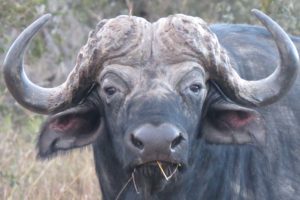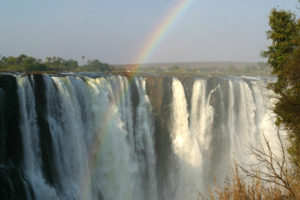

Taking advantage of our annual timeshare at Lokuthula, we had a wonderful week up at the Falls. What a treat! As we arrived we found the low maintenance lawnmowers out on the lawn as usual – a sounder of warthog in the company of a huge boar with an impressive set of warts and massive tusks and a trio of dainty bushbuck. As it was marathon Sunday the second day we were there, accommodation was packed to the rafters and the town was seething, not only with tourists but some 2000 marathon participants. We decided to absent ourselves from all the marathon hype and took ourselves off along the river for breakfast, through the Zambezi National Park. It is evident that the rainy season did a fair amount of damage to the roads in the park but fortunately, where we wanted to travel, had been recently graded despite some spots where the grader obviously had very little impact. We stopped off at fishing spot number 10 for coffee and fruit while watching a herd of impala, a large flock of white-fronted bee-eaters darting in and out of the bank, an Egyptian goose sunning itself, a pied kingfisher noisily looking for breakfast too and two pied wagtails twittering away near a pair of sun loving wire tailed swallows. A couple of white crowned lapwings spectacularly and acrobatically harassed an African harrier-hawk (gymnogene) out over the water who did some equally spectacular acrobatic flying to escape! Later an osprey flew by but didn’t linger to be admired.
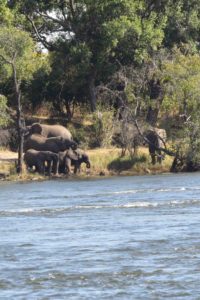
After another short drive further along but before the road got too bad, we started back to find a fishing spot for our breakfast. Number six which also has a lovely vista was pretty closed in with fallen trees across the road, and a herd of elephants were fast approaching so we withdrew to another spot further down which was just as beautiful and where, from a safe distance, we could watch the herd drink.
During our week, we had several forays into the park, along the river as well as along Chamabonda Vlei, and had a mixed bag of sightings during those drives – some large herds of buffalo, elephant, warthog, impala, kudu, spotted hyena, a fleeting glimpse of some eland, baboon and vervet monkeys. We even came across lion one morning attempting a buffalo hunt.
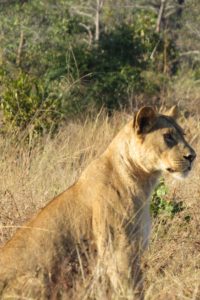
However, with a disdainful look from some of the outriders, the herd crashed off into thick bush and the lions retired to sun themselves on an anthill. A short while later, hearing what we thought was a heavy vehicle approaching, we realized that the buffalo were stampeding towards the now resting lion. It was quite spectacular as we watched the seething sea of black thundering through the brush, a rolling, bellowing tide of jostling bodies, startled oxpeckers and dust flying, chasing the lion off!
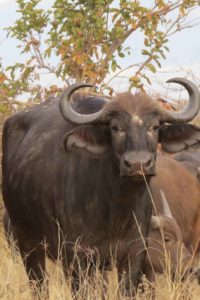
Chamabonda vlei is very well maintained thanks to the efforts of Trevor Lane and Bhejane Trust who have put in a number of solar units all along the vlei. There is a new hide at Timots pan which is looking good. Towards the bottom end near the camping platform, the grass is very long and rank as no mowing has yet been done so we didn’t see any animals except for a couple of warthog. We did see two Kori bustards, one of which took to flight like an overloaded, lumbering boeing, and along a particularly sandy patch of road, a large number of little bee-eaters were obviously attracted by something as the road ahead of us was littered with them before taking off at our approach. Birding was great and waiting for a lift one morning, we had a delightful hour bird watching near the Zambezi River drive entrance, walking up to the small dam next to the elephant ride place and through the boat club car park, adding to our list with a great variety. We were staggered at the many, many coveys of Swainson’s spurfowl that we came across – chicks of all ages including some two inch tiny tots scuttling off into the bush.
The Zambezi River is flowing very fast and is full, full, full so walking in the rain forest was extremely wet and viewing was fairly limited! The Victoria Falls as always was an awesome sight once we’d trudged our way through all the masses! We dried off in the sun at the Lookout Restaurant overlooking that spectacular view of the gorges below the bridge while having lunch and watching some of the adrenaline junkies take on the gorge swing and the zip line as several others took their turn bungi jumping off the bridge. Yet again, Victoria Falls Safari Lodge did not disappoint. One evening we called in for a drink and were treated to a spectacular sunset as a herd of buffalo with some very young calves came in to drink, trailing a large red dust cloud, lit up by the late evening rays.

We also enjoyed a delicious lunch there one day so we could watch the vultures being fed which is always quite a sight drawing many oohs and aahs from the tourists. The lodges are very well maintained and the staff throughout the complex so friendly, helpful and above all cheerful which makes staying there such a pleasure.
Planning on spending the weekend in Hwange, we took the road less traveled – through the Matetsi area past the border crossing turn off to Pandamatenga and on to Robins. It’s a fairly corrugated route, rattling the old bones not only of the passengers but our trusty much-traveled vehicle, but it winds through some rather picturesque country. After having had such a fabulous and luxurious time at the Falls, getting to Robins seemed a huge come down. However, on reflection, although we have visited Sinamatella often and thought how badly off that camp is, Robins must surely be the runt of the litter when it comes to it receiving any financial assistance to maintain the place. The staff there were very welcoming and pleased to see us, helpful and friendly. The chalet assigned to us was “not operating” so we were given another across near the camping ground. The chalet was spotless with comfortable beds but the less said about the ablution facilities the better with only one of the two ablution blocks semi-operable. We went off for an afternoon drive, starting off with visiting Little Tom’s which is a sorry sight since it was burnt and has not been rebuilt. However, the water there was plentiful, the surface dotted with purple waterlilies. Again, the rainy season had obviously wreaked havoc with the roads but some had recently been graded although there were a few trickier spots that were a bit dodgy. We could just make out the backs of elephant in the long grass of the vlei while traveling through to Big Tom’s where we had our lunch, the platform there having fairly recently been revamped.
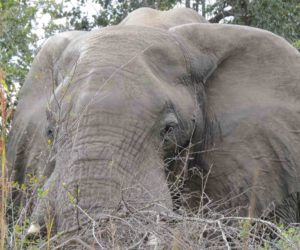
The water level was excellent and we had a nice quiet time bird watching with the spotting scope. The number of Bateleur eagles we saw in the Robins area is amazing and at one point, crossing one of the salt springs, seven Bateleurs of varying ages took off from the spot where they’d been paddling. While at Big Toms we watched an adult black chested snake-eagle interacting with a juvenile. Both birds were spectacularly marked and their aerial display quite something to watch. Sadly, there were disappointingly few birds at Salt Pan but we did get to see five black storks, their glossy plumage shining metallic maroon and green in the sun with bright red beaks and legs. We traveled on a newly graded road to Dolilo pan where the borehole has just been revamped and a solar unit recently installed before turning back to camp. Interesting country but aside from several ostrich which fluffed up at our approach, we didn’t see much. The Robins area has always hosted large flocks of helmeted guineafowl and the birds have obviously bred very well again this year. We also came across some tiny double banded sandgrouse chicks being herded along by a handsome set of parents.
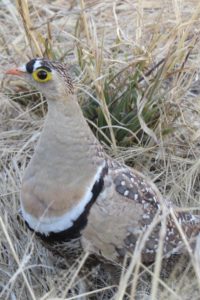
Provided with a nice stack of firewood, we enjoyed a braai under a star studded sky, continuously serenaded by barn owls, scops owls, the odd hyena and bats swooping around. Our night was punctuated by barn owl chicks ensconced in the roof of our chalet – we knew when one of the parents was approaching with food as the chicks started hissing and screeching until we heard the thump as the parent landed and the stamping around as the chicks were being fed, the noise dying down as the parent fluttered off again.
The following morning, we set off a little after six just as dawn was breaking, a gorgeous roseate flush on the horizon, followed by a crimson orb that popped up very quickly, turning a startling yellow in no time at all, washing the eastern horizon a soft lemon. We stopped off at Deteema to have a look – the water there is great and the Mike Edwards hide is very well maintained. A small herd of impala were grazing quite contentedly close by but there was evidence of recent lion activity. The camp attendant at the site, said that lion had been heard at four that morning, there were huge pug marks on the road between the camps and to one side, a bit of bloodied bone being picked over by a hooded vulture. On then through to Main Camp, stopping off at the various pans along the way. The water all along the way is phenomenal for this time of the year and so heartening to see. The new hide at Shumba has been well built and overlooks the brimming pan where we watched a pair of mating hippos while the rest of the pod kept a safe distance. Dwarf Goose pan was a delight with a flotilla of 15 teenaged spurwing geese and a pair of fussing Egyptian geese with three downy goslings, a few little grebe and two African jacanas also with youngsters. The natural pans along the way still hold quite good water in places and the level of water at Danga, Shapi, Whitehills, Guvelala and Boss Long One is high. Danga – not an FOH pan – is still being pumped with a diesel unit, and although there are still those skeptics who bewail the fact that solar is “unsightly” and “looks out of place”, seeing the pump unit there, despite being enclosed in green shade cloth, belching out smokey fumes and noise with the surrounds coated in black sludge, makes us even happier that solar is becoming more prevalent. Nyamandhlovu is very full and the vlei there was full of animals – zebra, wildebeest, black backed jackals, baboon, waterbuck, the usual enormous crocs out sunning themselves and hippo in the water. Along the loop road some of the depressions were obviously still damp as several sounders of warthog were down on their front knees, butts in the air, rootling around with their snouts.

Having settled into our lodge, we took a largely uneventful drive down to Kennedy One and back, not seeing a great deal. That evening, we had a tasty supper at the Waterbucks Head while John and Gary caught up with the chat.
On Sunday, John went off for an early morning drive and had a hugely successful time driving through to Caterpillar, Dopi, past Nyamandhlovu and returning to camp via Balla Balla. He saw an obliging side striped jackal that stood for a bit to be admired, a lovely herd of roan with some small babies, elephant, kudu and impala and just as he turned for camp via Balla Balla, he came across a group of lionesses. Judging by their pace and single mindedness, it was obvious they were out hunting and we heard later that this was a group of lionesses that did have small cubs, evidently hidden away somewhere while the moms went in search of food. The water all along the route was, again, lovely to see and although Gary told us there was a problem with one of the the solar units at Kennedy Two and at Ngweshla, we have subsequently heard that they are both fixed up and working well again. It certainly was great to see so much water at the onset of the “big dry” – and it is great that much needed funds do not have to be used on endless supplies of diesel.
Once again, a huge thank you to all interested parties, to the donors, those doing such great work in the park and in particular, Gary who is having a hard time of it trying to get fire breaks done before its too late!
John and Jenny Brebner
